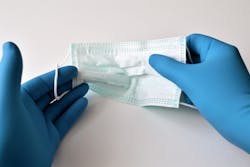PPE still lacking in nursing homes as COVID-19 doubles down
A new study detailing U.S. nursing home preparedness amid the COVID-19 pandemic finds that 20 percent of facilities had less than a week's supply of at least one type of personal protective equipment (PPE), according to a news report from the Center for Infectious Disease Policy and Research (CIDRAP) at the University of Minnesota.
The report, published by the U.S. Public Interest Research Group (US PIRG), said that seven months into the pandemic, shortages of critical PPE like N95 respirators and medical gowns had worsened rather than improved. The shortages were reported to the U.S. Centers for Medicare & Medicaid Services (CMS) by 2,981 (19.9 percent) of the nation's 15,000 nursing homes; in total, the affected homes have 226,495 residents.
From May to August, 46 percent of all nursing homes reported that they did not have even a week's supply of at least one type of PPE. The dearth of supplies worsened over the summer, with three times as many facilities reporting that they had no N95s, gowns, or eye protection in late August as in mid-July.
As of late August, about 2,500 homes (16.8 percent) were low on or out of N95s, 1,400 (9.3 percent) were low on surgical masks, 1,600 (10.7 percent) were nearly out of gowns, 1,250 (8.4 percent) were running out of eye protection, 700 (4.6 percent) were low on gloves, and 600 facilities (3.9 percent) had no hand sanitizer or were about to run out of it.
The report authors noted that a one-week supply of PPE is the minimum acceptable amount because facilities can use up that supply in 1 or 2 days if an outbreak occurs, leading to PPE rationing or foregoing of it all together, amid uncertainty as to when the next shipment will arrive.

